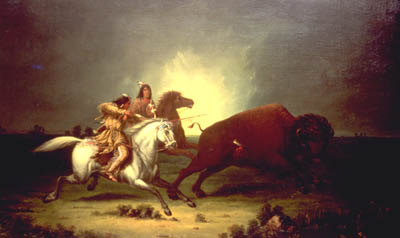We associate the self-taught artist Paul Kane (1810-71) with romantic paintings of Indigenous people and credit him with accurately depicting specific individuals, their affiliations, and the landscapes of the "Great Nor'West." And, with the publication under his name of the travelogue Wanderings of an Artist in l859, he is acknowledged as a reliable source of historical information that describes his search for this remarkable subject matter.

|
| Paul Kane self portrait, 1846-48, oil on paper (courtesy Stark Foundation, Orange, Texas). |
Indeed, this best-selling book and Kane's extensive output of oil on canvas paintings created mainly in the 1850s attest to one of the more interesting and remarkable careers of any Canadian artist.
Kane was born in Ireland and came, aged nine, with his family to what was then British North America. The family settled in "muddy York," today's Toronto, around 1820. Artistically he identified with Europe, as was typical for an aspiring artist and colonial subject.
By 1841, at the age of 30, Kane began a three-year sojourn overseas learning all he could by "copying the European masters." While in London he saw the first "Wild West Show" ever staged when American artist George Catlin exhibited paintings and artifacts from his own journey west in the 1830s. Kane decided to do for British North America what Catlin believed he had done for the United States. This was to capture the essence of the "disappearing Indian" before it was too late. With this new and somewhat paradoxical resolve, Kane returned home in 1844.
Paul Kane's oeuvre is based on two trips. The first took him around the Great Lakes in the summer of 1845 and the second was a truly fantastic voyage following the Hudson Bay fur trading routes as a kind of faux voyageur. Rather than hauling furs and paddling, he sketched and painted for two and a half years over thousands of wilderness kilometers. The depth of his achievement can be understood only by comparison to other great adventurers. Kane wasn't a master navigator and explorer like Jacques Cartier or Samuel de Champlain. Nor does he rank in achievement with the de La Vérendrye brothers or David Thompson.
As artists go, Kane was one of the hardiest. He displayed the stamina required to keep pace with the men of the Hudson's Bay Company through dense forests, over rugged mountains, along the raging waters of the Columbia river, mushing with dog sleds and enduring extreme cold and all the other privations. Yet he managed to fulfill his idea of creating art, returning with hundreds of artifacts, copious field notes, and 700 sketches of the Indigenous people he met and the landscapes he travelled.

|
| Dark tones and Europeanized landscape in Kane's 1850s studio painting, Assiniboine Chasing Buffalo, based on an Italian print (Courtesy Stark Museum of Art, Orange, Texas) |
When Paul Kane exhibited a selection of his work in Toronto upon his return in 1848, his viewers were astonished. His pictures gave them glimpses of the country that they could never have imagined. The oil-sketches on display, such as the Medicine Pipe Stem Dance, represented the first solo exhibition of any artist in British North America. It was the self-taught artist's homecoming triumph, an event organized by his future wife Harriet Clench. What's more, Kane was among the first to create what would later be known as Canadian art. Yet this captivating, landmark event closed in less than three weeks. One wonders why.
When Kane returned to Toronto in 1848 his true mission was yet to unfold. He was not interested in showing the clear light of the western skies, nor the bright colours of the Indigenous people's ceremonial garments, nor the rugged landscape that he had so intensely traversed. He wanted instead to fulfill his Catlin-inspired assignment of documenting the "wild west" by polishing his works according to the stylistic discourse of his day: idealized Indigenous people, Europeanized landscapes, muted colours. With the patronage of G.W. Allen, a wealthy Toronto financier, he proceeded to transform his sketches into oil paintings conforming to the contemporary standards of Europe. Thus Paul Kane is remembered for his romanticized images of the "Noble Savage," not his more authentic fieldwork.
A similar relationship exists between his field writings and his published book. Kane's field notes are full of first hand impressions of Indigenous life that prove, as Professor Ian MacLaren has shown, that the real Paul Kane is not the voice of the gentleman traveller depicted in Wanderings of an Artist. The published text, written to satisfy the expectations of his audience, is somewhat removed from Kane's actual observations.
The legacy of Paul Kane is complex. The pictures and the writings that are most widely known are of a highly romantic and embellished sort. The language of the published text is racially patronizing, the images exotic and idyllic. His interest in the "Wild West" originally led him to search out authentic, uncorrupted Indigenous life. What he found he recorded more faithfully in his field notes and his sketches. What he produced back in his Toronto studio later on is an artistic rather than historical record. But paradoxically this is what became the record. The artist adventurer saw his opportunity to record a turning point in North American history, and he did so in a manner popular to his times. In ours, he provides the opportunity to think critically about his legacy.

 Share on Facebook
Share on Facebook Share on X
Share on X Share by Email
Share by Email Share on Google Classroom
Share on Google Classroom
